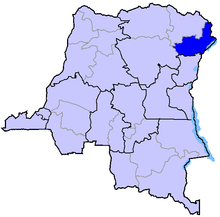Ituri Rainforest: Difference between revisions
Add references section (testing) and/or general fixes. |
No edit summary |
||
| Line 1: | Line 1: | ||
[[Image:Région Ituri République démocratique du Congo.png|right|thumb|Map of [[Ituri]] within the [[Democratic Republic of Congo|DRC]]]] |
[[Image:Région Ituri République démocratique du Congo.png|right|thumb|Map of [[Ituri]] within the [[Democratic Republic of Congo|DRC]]]] |
||
The '''Ituri Rainforest''' is located in the [[Ituri]] region of eastern [[Democratic Republic of the Congo]]. The Ituri Rainforest is about 63,000 square kilometres in area, and is located between 0° and 3°N and 27° and 30° E. Elevation in the Ituri ranges from about 700 m to 1000 m. The average temperature is 31°C (88°F) and the average humidity is about 85% (Wilkie 1987).<ref name="Wilkie">Wilkie, David. S. 1987. Impact of Swidden Agriculture and Subsistence Hunting on Diversity and Abundance of Exploited Fauna in the Ituri Forest of Northeastern Zaire. Unpublished Ph.D. dissertation, Department of Forestry and Wildlife Management, University of Massachusetts.</ref> About one-fifth of the [[rainforest]] is made up of the [[Okapi Wildlife Reserve]], a [[World Heritage Site]]. It is also the home of the [[Mbuti]] [[pygmy|pygmies]], one of the hunter-gatherer peoples living in equatorial rainforests characterised by their short height (below one and a half [[metre]]s, or 59 inches, on average). They were the subject of a study by [[Colin Turnbull]], ''The Forest People'', in 1962. |
The '''Ituri Rainforest''' is located in the [[Ituri]] region of eastern [[Democratic Republic of the Congo]]. The Ituri Rainforest is about 63,000 square kilometres in area, and is located between 0° and 3°N and 27° and 30° E. Elevation in the Ituri ranges from about 700 m to 1000 m. The average temperature is 31°C (88°F) and the average humidity is about 85% (Wilkie 1987).<ref name="Wilkie">Wilkie, David. S. 1987. Impact of Swidden Agriculture and Subsistence Hunting on Diversity and Abundance of Exploited Fauna in the Ituri Forest of Northeastern Zaire. Unpublished Ph.D. dissertation, Department of Forestry and Wildlife Management, University of Massachusetts.</ref> About one-fifth of the [[rainforest]] is made up of the [[Okapi Wildlife Reserve]], a [[World Heritage Site]]. It is also the home of the [[Mbuti]] [[pygmy|pygmies]], one of the hunter-gatherer peoples living in equatorial rainforests characterised by their short height (below one and a half [[metre]]s, or 59 inches, on average). They were the subject of a study by [[Colin Turnbull]], ''The Forest People'', in 1962. |
||
[[Image:kgituributterfly.jpg|thumb|left|250px|Ituri forest butterfly]] |
|||
The Ituri Rainforest was first traversed by Europeans in [[1887]] by [[Henry Morton Stanley]] on his [[Emin Pasha Relief Expedition]]. |
The Ituri Rainforest was first traversed by Europeans in [[1887]] by [[Henry Morton Stanley]] on his [[Emin Pasha Relief Expedition]]. |
||
Revision as of 20:49, 26 April 2008

The Ituri Rainforest is located in the Ituri region of eastern Democratic Republic of the Congo. The Ituri Rainforest is about 63,000 square kilometres in area, and is located between 0° and 3°N and 27° and 30° E. Elevation in the Ituri ranges from about 700 m to 1000 m. The average temperature is 31°C (88°F) and the average humidity is about 85% (Wilkie 1987).[1] About one-fifth of the rainforest is made up of the Okapi Wildlife Reserve, a World Heritage Site. It is also the home of the Mbuti pygmies, one of the hunter-gatherer peoples living in equatorial rainforests characterised by their short height (below one and a half metres, or 59 inches, on average). They were the subject of a study by Colin Turnbull, The Forest People, in 1962.
The Ituri Rainforest was first traversed by Europeans in 1887 by Henry Morton Stanley on his Emin Pasha Relief Expedition.

References
- ^ Wilkie, David. S. 1987. Impact of Swidden Agriculture and Subsistence Hunting on Diversity and Abundance of Exploited Fauna in the Ituri Forest of Northeastern Zaire. Unpublished Ph.D. dissertation, Department of Forestry and Wildlife Management, University of Massachusetts.
External links
- Osfac
- Rainforest people - Baka Pygmies Culture of the African rainforest people, with photos of nature and animals
